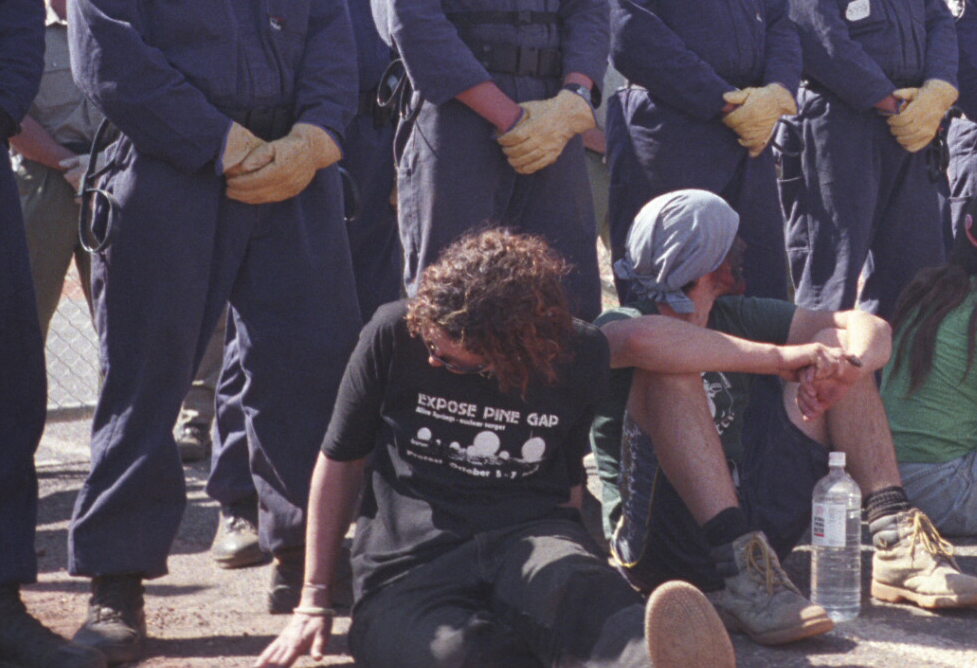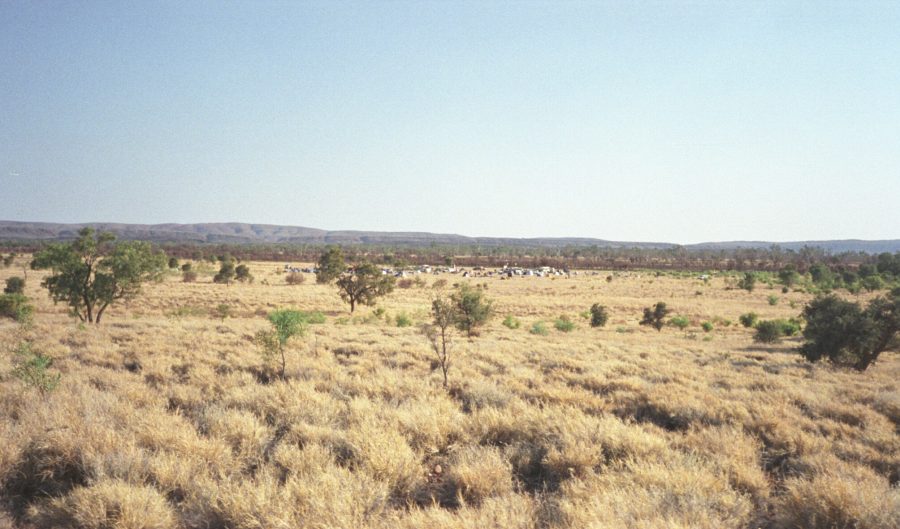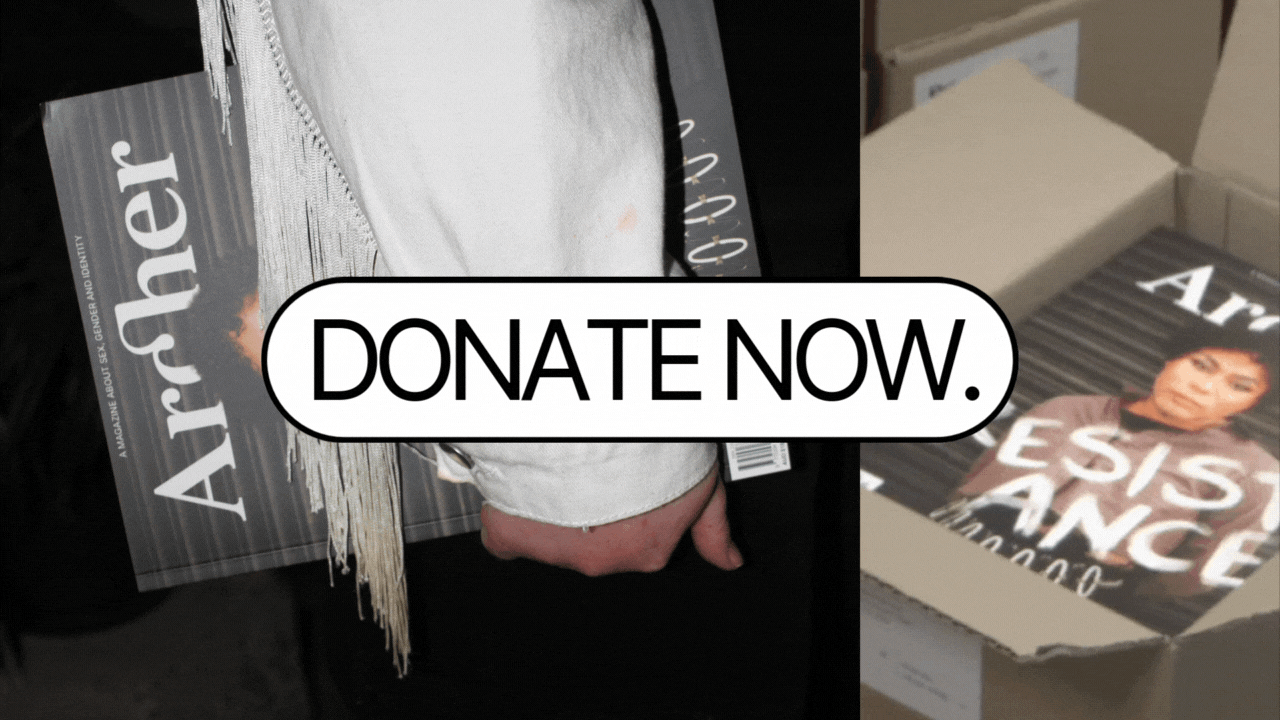Pine Gap to Gaza: Surveillance from stolen Arrernte lands
By: Celeste Liddle

They press a button
And this country looks away
Press a button
Another death another day
Shifting sands wipe conscious minds
To global warfare they turn blind
They press their buttons
They press their buttons
– Celeste Liddle – ‘Golf Balls’, 2024
An unusual fact about me is that, unlike most other Aboriginal people, I am just Arrernte.
While many of us in the community when introducing ourselves will often link our heritage to various Indigenous nations, I am Arrernte via three lines – an Arrernte, Arrernte and Arrernte woman.
It probably wasn’t always the case – Arrernte lands are massive, and with the bordering lands such as the Warlpiri and Pintupi, the Arrernte shares equivalent ‘skin names’ to ensure right-way marriage is observed and culture is preserved correctly.
I can therefore guarantee that in the times before colonisation, my ancestors probably crossed those borders in marriage and customary sharing.
However, as an interior frontier – where the processes of colonisation began much later than the eastern seaboard – I have the privilege of looking back at who my Aboriginal ancestors were at that crucial time, and noting that they were all Arrernte.
This article appears in Archer Magazine #20, the RESISTANCE issue – buy a copy here.
Our lands are frequently a battleground.
To this day, the forces that are the Australian Government and the Australian media continuously use Mparntwe (Alice Springs) as a ‘flashpoint’ when talking about violence and social dysfunction.
This is allowed to continue because, as these bodies know, most Australians have never been to our lands, and via this community ignorance, they can continue to exploit this area as Australia’s version of the Wild West.
In turn, they use this ignorance to trial abhorrent policies like the Northern Territory Intervention – when the Federal Government of the day suspended Australia’s Racial Discrimination Act, forced communities to sign over the leases on their lands, and then sent army trucks in while banning alcohol, pornography and the right to spend welfare payments how they chose.
Or the Community Development Program – a forced long-term labour program for partially quarantined welfare benefits.
Due to their ignorance and racism, most Australians will simply accept these state abuses as necessary.
The alternative to this would be to recognise Mparntwe as the major desert centre that it is, and the fact that it is in dire need of infrastructure, collaboration and respect.
On any given day when I’m walking down the Todd Mall, I may hear six local languages being spoken, and it humbles me to know that despite the processes of colonisation that have impacted multiple generations of my own family, many desert people are remaining culturally knowledgeable and strong.
Existence as resistance, if you will.
All this introduction to my homelands is to highlight one very simple point – these lands are incredibly isolated, and successive governments have relied upon this fact for multiple reasons, and for multiple generations.
At best, this has meant that certain ancient rituals and practices can continue with little interference from the State.
At worst, this has meant that Alice Springs has long been the beating heart for the global war machine.
Lying just south of the town is the US military installation Pine Gap. And from my homelands, some of the worst atrocities are inflicted on other parts of the world.
Pine Gap is a series of domelike structures, sitting on unceded Arrernte lands, protected by some imposing ‘DO NOT ENTER’ signage and fencing.
It spies on regimes across the globe, feeding information back to the USA, supporting its military-industrial complex, along with those of its allies.
Such information includes coordinates for the launching of drone missiles, at least according to recent information that has leaked out of the facility.
It’s always been rich to me that much is said – and indeed amped up – about the violence perpetrated on the streets of Mparntwe when, just down the road, true violence has been facilitated for decades.
I am middle-aged enough to have noticed that the interest in Pine Gap facility has ebbed and flowed over the years.
When I was little, like so many other people at the time, I was told that Pine Gap was a space station, and being born at a time where the Soviet Union and the USA were conducting a lot of space exploration in a bid to claim global superiority for their respective regimes, this explanation made sense to me.
My first hints of any explanation otherwise were the anti-nuke protestors in the 1980s – hundreds of women’s peace activists, together with some local Traditional Owners, set up a Peace Camp in the Pine Gap Prohibited Zone.
Inspired by the women undertaking similar action at Greenham Common in the UK, the camp scaled fences in acts of sabotage and delivered gigantic papier-mâché missiles to the front gates of the compound.
A couple of years ago, the indomitable Miriam Margolyes learnt one of unique outcomes of this action while making her documentary series Almost Australian – women not only spread the global peace message at the camp, they also spread the love.
Due to this, Mparntwe has a long-standing, thriving lesbian population which is one of the highest, per capita, in the country.
It’s a remarkable fact to ponder – that in a space where intelligence was being collected to fuel the Cold War and the proxy wars this fight for global dominance kept creating, and where hundreds of women gathered to stop these atrocities and highlight Australia’s complicity and vulnerability, resistance blossomed into love and community.
That while powerful men sought to annihilate each other in fear and hatred, women in their own power instead loved and uplifted each other.
As an Arrernte woman, Pine Gap has long been a loathed thorn in my side.
I cannot think of a time that I have flown into the homelands and not flipped the bird at the military installation as the plane turns to come in for landing. I have written essays about it for university assignments. I have ranted about it on stages. I have made snide comments about it on social media.
While its existence and therefore Australia’s assistance in global conflict has remained a constant, however, I have witnessed community awareness of Pine Gap ebb and flow.
Every few years, a series of news articles will hit the press and people will be shocked for a few weeks, before the ‘out of sight’ mentality kicks in and Pine Gap is forgotten again.
Right now, Pine Gap is back on our screens.
In recent times, I have seen a large uptick in media coverage, combined with a podcast devoted to the facility, and a TV series.
Mainly, this interest has to do with current activists, such as the Mparntwe for Falastin organisers, or Arrernte activist Declan Furber Gillick.
As Israel drops bombs on the people of Palestine, their hospitals, universities and refugee tent villages, activists have now shut down access to Pine Gap a couple of times, reminding people that for as long as this facility is allowed to operate, Australia is complicit.
As earlier mentioned, the intel gathered at this place is used to launch drone missiles, and give coordinates so accurate that there is no mistaking the target from tens of thousands of kilometres away.
This information then kills children, it destroys civilisations, and it continues the colonial project.
As information is fed back to the USA, the USA then can feed it on to allies – Israel obviously being a key one in the Middle East.
It represents so much more than this though.
In the decades of the Cold War, Pine Gap was a strategically-placed base which allowed the USA to monitor the operations of the Soviet Union, and the communist countries throughout Asia. The site was chosen due to its remoteness, its inaccessibility, and its ability to provide a strategic advantage.
As a recent article by Peter Cronau in The Saturday Paper outlines, right now, though Gaza is certainly attracting some of Pine Gap’s surveillance operations, the majority of its attention is, most likely, China.
The battle for the world’s superpower is hotting up again, and the USA is monitoring China’s nuclear capabilities.

Image: Sam Wilson
How will this unfold over the decades, and what role is Australia likely to play, particularly if Pine Gap remains a functioning base?
We already have our answer for this, I believe. The Cold War was called such because, rather than a direct conflict between the USA and the former Soviet Union, it was a series of proxy wars staged in other countries in a bid for each of these powers to destabilise the global influence their enemy had.
Whether it was Vietnam, or Korea, or Iran-Iraq, or so forth, the superpowers were funnelling money and munitions, sometimes into both sides, to ensure that communism or capitalism did not emerge victorious.
The cost was millions of lives globally – civilians and forces – a lot of damaged souls, and the normalisation of war. Even following the Cold War, to my knowledge there has never been a time when the USA has not been at war.
The military-industrial complex is real – war may cost money, but it also makes money in munitions sales and allied land grabs, and it builds power, so on it rages.
This article appears in Archer Magazine #20, the RESISTANCE issue – buy a copy here.
Australia has long been an ally to the USA, and I don’t see that changing.
We are a country that came about with the racist erasure of several millennia’s worth of history via the false doctrine of terra nullius (land belonging to no one).
Then, once the land was grabbed based on this lie, the leadership of this country set about creating a constitution and a series of policies (such as the White Australia policy) designed to ensure the desired whiteness reigned supreme.
Australia is a gigantic landmass, but one that is sparsely populated and geographically isolated.
Geopolitically, latching onto a much larger power for ‘safety’ (really, to maintain these white status quos) makes sense to our politicians. It even doesn’t seem to bother our leadership if that geopolitical relationship is thoroughly subservient.
Hell, former prime minister John Howard actually revelled in this subservience – he could not fall over himself fast enough to commit Australian troops to the Iraq War.
As hundreds of thousands took to the streets to protest the ‘war for oil’, we were ignored by those doing their devil’s dance at the top.
And thus, several years down the track, hindsight has shown we were correct to protest – there were no ‘weapons of mass destruction’, and instead, our leadership has come out the other side cast as war criminals.
Which, in a rather roundabout way, brings me back to Pine Gap. Because even when Australia is not committing troops to ground offensives we should never have been involved with, we are always complicit.
And we are always complicit from stolen Arrernte lands.

Image: Sam Wilson
Wars are being waged from a place which still, to this day, is treated like a Wild West frontier town, yet these lands nourished and protected peoples for 4000 generations.
According to The Lancet’s ‘Counting the dead in Gaza: difficult but essential’, [as of July 2024] the official death toll in Gaza has already climbed beyond 40,000 deaths.
Meanwhile, Australia sits back, happily believing this is another world away, and not one that has been facilitated in our own backyards.
Indeed, our leadership have not just been wilfully turning a blind eye to what our allies are helping orchestrate at Pine Gap, they have been contributing to the narratives that ensure Israel is allowed to commit genocide mainly unchallenged.
As I write this, it has become common knowledge that the Victorian Government signed a Memorandum of Understanding with Israel’s Ministry of Defence only two years ago, and the Victorian premier at the time – Daniel Andrews – has just been announced as the co-patron of the Labor Friends of Israel.
The Andrews Government also invested in Elbit Systems – a main supplier to Israeli Defence Forces. The Federal Government, meanwhile, have spent more time crying about protest actions that have defaced their electoral offices than they have condemning this genocide.
Apparently Palestinian lives are not as important as a cleaning bill picked up by taxpayer dollars.
Additionally, Australia has its own historical interests in maintaining Israel, even in the wake of such horrors, that go beyond our allies.
This is the fact that an alternate Jewish homeland – the Kimberley Plan – was proposed in Western Australia by the Freeland League (an alternate movement to the Zionist movement), and this was twice knocked on the head by successive governments.
Why? Because both the Curtin Government and the Menzies Government feared that resettled Jewish people would eventually make their way to the major cities and “change the culture” – a thing they wished to avoid at all costs while the White Australia policy was still in play.
No consultation was held with Aboriginal Traditional Owners of those lands to see how they felt about the idea, naturally.
I cannot claim to speak for them, but I daresay had they been consulted, they would have most likely come up with more humane solutions.
Instead, Australia’s own antisemitism then was reinforced when Dr Evatt – the then Australian Labor Party attorney-general – became a key architect of the Partition Plan.
Australia played a crucial role in carving up lands that weren’t ours but that had been fought over by our allies for decades, creating imposed places for Palestinians and Israelis. This plan set the scene for the 1948 Nakba, and much of what has precipitated since.
This country has been invested in Israel, and by extension, the USA’s war efforts in the Middle East, from the beginning, due to its own xenophobia and racism.
And so, we fast-forward to now, and still those giant golf balls on Arrernte lands transmit their intelligence, leading to the death and destruction of other desert peoples on the other side of the world.
As an Arrernte person, my heart hurts that the stolen lands of my ancestors are being used in such a brutal and devious way.
And I wonder, how can we resist this when so many do not have the knowledge?
I joked, just last week, about how I thought a road-train going up the Stuart Highway might potentially take a corner a bit wide and clip the power lines supplying the facility.
It’s not going to happen (probably…), but if, at this point in history, when knowledge of Pine Gap is on the rise again, and a genocide is being transmitted in real time by social media, we’re lax and complicit if we don’t seize our opportunities to dismantle the war machine.
Perhaps it’s time to reinvigorate the love and activism of the peace encampments, and via direct action and blockades, ensure the message of ‘never again’ gets captured on the global media radars.
We can join the boycotts and the divestments, but unless we are targeting Australia’s own contributions – whether that’s trade or intelligence – things will keep slipping by, unnoticed and unmonitored.
There has been enough killing on Arrernte lands. Now is the time to stop the killing being enabled from Arrernte lands.
From Lhere Mparntwe (Todd River) to the Sea.
This article first appeared in Archer Magazine #20, the RESISTANCE issue.
Related stories...
- Something went wrong, no related stories were found.





